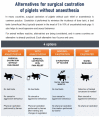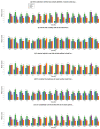Exploratory Survey on European Consumer and Stakeholder Attitudes towards Alternatives for Surgical Castration of Piglets
- PMID: 32998259
- PMCID: PMC7600221
- DOI: 10.3390/ani10101758
Exploratory Survey on European Consumer and Stakeholder Attitudes towards Alternatives for Surgical Castration of Piglets
Erratum in
-
Erratum: Aluwé, M. et al. Exploratory Survey on European Consumer and Stakeholder Attitudes towards Alternatives for Surgical Castration of Piglets. Animals 2020, 10, 1758.Animals (Basel). 2020 Dec 14;10(12):2388. doi: 10.3390/ani10122388. Animals (Basel). 2020. PMID: 33327668 Free PMC article.
Abstract
Surgical castration of piglets without pain relief is still common practice in many countries. Possible alternatives for surgical castration are application of pain relief or anaesthesia or production of boars (entire males) and immunocastrates. Each of these alternatives faces advantages and disadvantages which may result in different citizen attitudes and consumers acceptability. Understanding which practice is acceptable to whom and why may further stimulate implementation. Consumer (n = 3251) and stakeholder (n = 1027) attitudes towards surgical castration without pain relief, surgical castration with anaesthesia, immunocastration, and production of boars were surveyed from April to June 2020 via an online questionnaire in 16 countries (>175 respondents per country). Surgical castration without pain relief was separated from each of the alternatives due to animal welfare and showed the lowest acceptability (32%). Within the alternatives, a further partitioning between the alternatives was based on perceived quality and food safety, with an acceptance of 85% for applying anaesthesia, 71% for immunocastration, and 49% for boar production. Differences depending on professional involvement and familiarity with agriculture could be observed, mainly for the acceptance of surgical castration without anaesthesia, immunocastration, and boars. Castration with anaesthesia was highly accepted by all types of respondents.
Keywords: acceptability; anaesthesia; analgesia; boar production; cluster analysis; immunocastration; infographic; online questionnaire.
Conflict of interest statement
The authors declare no conflict of interest.
Figures







References
-
- European Commission Establishing Best Practices on the Production, the Processing and the Marketing of Meat from Uncastrated Pigs or Pigs Vaccinated Against Boar Taint (Immunocastrated)—Final Report. [(accessed on 1 September 2020)]; Available online: https://ec.europa.eu/food/sites/food/files/animals/docs/aw_prac_farm_pig....
-
- European Declaration on Alternatives to Surgical Castration of Pigs. [(accessed on 1 September 2020)]; Available online: https://ec.europa.eu/food/sites/food/files/animals/docs/aw_prac_farm_pig....
-
- Weber S., Das G., Waldmann K.H., Gauly M. Labour time required for piglet castration with isoflurane-anaesthesia using shared and stationary inhaler devices. Berl. Munch. Tierarztl. Wochenschr. 2014;127:108–114. - PubMed
-
- CASTRUM Consortium Pig Castration: Methods of Anaesthesia and Analgesia for All Pigs and Other Alternatives for Pigs Used in Traditional Products. [(accessed on 1 September 2020)]; Available online: https://www.boarsontheway.com/wp-content/uploads/2018/09/Castrum-study.pdf.
LinkOut - more resources
Full Text Sources
Miscellaneous

